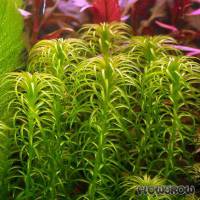



Lagarosiphon major exclusively grows submersed, floating or rooted, in stangant cool waters, originally in the south of Africa, which has cooler climate zones than the rest of that mainly tropical continent. However, it has been introduced into Western Europe and New Zealand. Since 1906, L. major has been in use in the aquarium hobby, it has been partially crowded out by more warmth-tolerant and more attractive species, though. For many years, the curly water thyme was known under the synonym Lagarosiphon muscoides var. major and its trade name "Elodea crispa".
Brazilian waterweed (Egeria densa) looks pretty much like this plant, however, we can discern L. major by its considerably harder leaves with a pronounced downward bend. Moreover, its leaves are mostly alternate (1 leaf per node, instead of leaf whorls of 3 or more, which E. densa has).
The cultivation of Lagarosiphon major is pretty similar that of to its South-American cousin, Egeria densa. Medium lighting and cooler water temperatures (around 18-24 °C) are pretty much all this plant needs. If water temperatures are too high over a longer period of time, the plant decays within weeks. Its growth rate is fastest in soft water. However, it can also be kept in harder water without problems.
In the aquarium, this stem plant can either be planted in the substrate or left floating. Once in the tank the plant will grow exceptionally fast! It can be propagated by cuttings of lateral or top shoots.
These days, L. major is only rarely used in aquarium layouts. However, its attractive transparent downbent leaves make it a beautiful background plant for cool-water tanks like e.g. for goldfish or white cloud mountain minnows (Tanichthys albonubes).
<a href="https://www.flowgrow.de/db/aquaticplants/lagarosiphon-major" target="_blank"><img alt="Lagarosiphon major" title="Lagarosiphon major" src="https://www.flowgrow.de/db/widget/aquaticplants/lagarosiphon-major" /></a>
[url=https://www.flowgrow.de/db/aquaticplants/lagarosiphon-major][img]https://www.flowgrow.de/db/widget/aquaticplants/lagarosiphon-major[/img][/url]
[widget=aquaticplants/lagarosiphon-major]Lagarosiphon major[/widget]